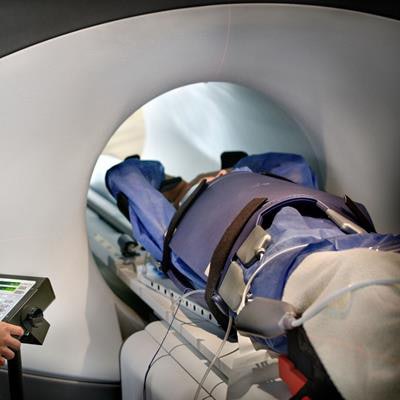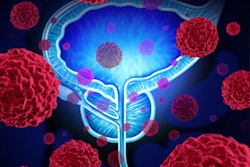
Hypofractionated stereotactic body radiotherapy (SBRT) combined with MRI guidance to treat prostate cancer patients produced an impressively low incidence of early gastrointestinal (GI) and genitourinary (GU) toxicities, according to a study from the Amsterdam University Medical Centers (VUmc). The low acute toxicity rates seen in 101 men, the majority with high-risk disease, even surpassed the researchers' estimates, and supports the viability and safety of this extreme, hypofractionated radiotherapy scheme.
VUmc's radiotherapy department began using MR-guided radiotherapy (MRgRT) in May 2016 and almost immediately started treating prostate cancer patients. MRgRT improves visualization of the target volume and adjacent healthy organs such as the rectum and bladder prior to and during treatment -- without requiring implanted fiducial markers. It also enables adaptive planning, such as plan reoptimization, prior to delivery of each fraction.
 Principal investigator Dr. Anna Bruynzeel, PhD.
Principal investigator Dr. Anna Bruynzeel, PhD.Principal investigator Dr. Anna Bruynzeel, PhD, and colleagues conducted a prospective single-arm phase II study of 101 prostate cancer patients to investigate the impact of hypofractionated MRgRT on toxicities and quality of life. They hypothesized that adaptive MRgRT with small uncertainty margins could limit acute grade 2 or greater GU toxicity to 40% and grade 2 or greater GI toxicity to 15%.
The majority of patients (59.4%) had high-risk cancers, 36.6% had intermediate-risk cancers, and 4.0% had low-risk localized cancers with no lymph node involvement or distant metastases. Most patients (82%) were also receiving androgen derivation therapy.
The up-to-14-day treatment regimen comprised five fractions of 7.25 Gy to the prostate, with simultaneous integrated relative sparing of the urethra. Immediately prior to each fraction, the team performed a high-resolution MRI and rigidly registered this to the simulation MRI by alignment on the clinical target volume (CTV). They generated two plans on each day of treatment: a baseline plan recalculated on images reflecting the anatomy of the day; and a reoptimized plan prioritizing coverage of the planned target volume (PTV), which used the same number and direction of beams as the baseline plan.
For each treatment, patients were imaged in real-time with planar MRI to monitor intrafraction changes and maintain gating with a 3-mm boundary around the CTV. The team compensated for any changes in CTV position using 2D table shifts (applied in more than 20% of fractions). If the CTV position changed by more than 3 mm (seen in 6% of fractions), they halted irradiation and performed a repeat volumetric MR scan to make a 3D table correction.
The authors reported that 23.8% of patients experienced grade 2 or higher GU toxicities during the first 90 days from the start of radiotherapy (study hypothesis 40%). The majority experienced radiation-induced cystitis and only 4% reported incontinence, which decreased over time. Six patients experienced grade 3 GU toxicities (International Journal of Radiation Oncology, Biology, Physics, 13 August 2019).
 The team used ViewRay's MRIdian system to deliver MR-guided hypofractionated radiotherapy to patients with prostate cancer. Image courtesy of ViewRay.
The team used ViewRay's MRIdian system to deliver MR-guided hypofractionated radiotherapy to patients with prostate cancer. Image courtesy of ViewRay.Only 5% of patients experienced grade 2 or higher GI toxicities (study hypothesis 15%), the majority of which were radiation proctitis, which resolved rapidly without intervention. The patients' most common complaint was feeling bloated; only one patient experienced rectal bleeding.
Toxicities peaked after patients received the last radiotherapy fraction. However, the authors note this peak may have occurred earlier prior to the first follow-up point and suggest that future trials using ultrahypofractionation should also include earlier time points.
The researchers point out the toxicity levels experienced by patients in this study were significantly lower than seen in a previous phase III study comparing conventional and moderately hypofractionated radiotherapy in 820 intermediate- and high-risk prostate cancer patients. In that trial, 42% of patients who had a 19-fraction radiotherapy experienced grade 2 or higher GI toxicity and 60.5% had grade 2 or higher GU toxicity.
"The low incidence of early GI toxicity, despite inclusion of the base of (or entire) seminal vesicles in 96% of patients, is likely to result from benefits of MRgRT, in particular the use of only 3 mm CTV to PTV margins, made possible by online CTV monitoring and daily plan reoptimization," the researchers wrote. "If our main clinical finding of significantly reduced GI toxicity is confirmed on longer follow-up, this may indicate that MRgRT could be a competitive technique with rectal spacers in combination with external-beam radiotherapy."
Bruynzeel told Physics World that she and her colleagues have administered more than 3,300 MRgRT fractions in treatments of more than 600 patients, about one-third of whom had prostate cancer. Other cancers treated included pancreatic, kidney, lung, and adrenal cancers, as well as liver metastases. The main common criterion is the possibility to treat these patients with extreme hypofractionated radiotherapy.
"Our clinical impression is that toxicity is lower than other radiotherapy options. Because MRgRT is a time-consuming procedure, we believe that it best suited for hypofractionated treatment," Bruynzeel said. "We encourage our prostate cancer patients to elect this treatment, but if they are not suitable candidates for MRgRT, or do not wish to travel to Amsterdam to VUmc, they receive more fractionated radiotherapy, 20 fractions of 3 Gy, after gold fiducials have been implanted."
Cynthia E. Keen is a freelance journalist specializing in medicine and healthcare-related innovations.
© IOP Publishing Limited. Republished with permission from Physics World, a website that helps scientists working in academic and industrial research stay up to date with the latest breakthroughs in physics and interdisciplinary science.



















